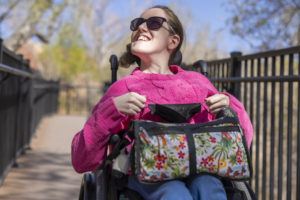What to Do Before Talking to Kids About Disabilities
Before talking to kids about disabilities, it’s a good idea to prepare yourself and do some research beforehand.
Here are some steps to take that can make this discussion go smoothly.
1. Research the Disability
First, research the disability. Use reliable resources such as hospital and government websites. You should be ready to answer any questions your child may have about the disability and its impact.
Some credible websites with information on different disabilities include:
- American Association on Intellectual and Developmental Disabilities (AAIDD): AAIDD is the oldest awareness and advocacy organization for intellectual and developmental disabilities.
- American Foundation for the Blind (AFB): In operation for more than 100 years, this nonprofit focuses on helping people with vision loss find employment, raise awareness, and more.
- American Speech-Language-Hearing Association (ASHA): Here you can find information on different hearing impairments, how to volunteer, and supportive resources.
- Autism Society: This organization connects families to resources and works to make meaningful change to support the autism community.
- Autism Speaks: This nonprofit organization advocates for people with autism spectrum disorder and works to connect them and their families with support and resources.
- Centers for Disease Control and Prevention (CDC): This government-funded organization provides information on a number of different diseases (like cerebral palsy) that lead to disabilities, including statistics, treatment, symptoms, and prevention.
- Cerebral Palsy Foundation (CPF): CPF focuses on helping people with CP access treatment, resources, and support.
- Global Down Syndrome Foundation: This nonprofit is dedicated to improving the lives of those with Down syndrome through advocacy, education, and research.
- Learning Disabilities Association of America (LDAA): Now in its 60th year of operation, LDAA connects children, parents, and educators to helpful solutions and a network of resources.
- Muscular Dystrophy Association (MDA): MDA works to empower, educate, and support people with muscular dystrophy and their families. It is led by volunteers and has been helping people with this condition for more than seven decades.
- National Down Syndrome Congress (NDSC): NDSC provides support for individuals with Down syndrome and their families and advocates on their behalf.
- National Organization for Rare Disorders (NORD): NORD is a nonprofit organization that has been operating nationwide for 40 years. It helps people with rare diseases feel seen and heard and provides them with the support they need.
- The American Association of People With Disabilities: This organization advocates for the rights of all people with disabilities in America, including physical, intellectual, and developmental disabilities.
- The ARC: This group supports individuals with intellectual and developmental disabilities and has hundreds of chapters across the country.
- United Cerebral Palsy (UCP): International nonprofit UCP provides services and advocates for people with disabilities.
2. Gather Kid-Friendly Resources
Once you have a firm understanding of the disability, gather kid-friendly resources about the condition. Ensure these resources are age-appropriate and accurate. Examples include picture books, websites, and videos.
Many of the websites listed above provide access to kid-friendly information on disabilities. These resources can give children a better understanding of a sibling, friend, or relative with a disability.
3. Consider Your Language Choices
 Next, think about your language choices when talking to kids about disabilities. Remember to use person-first and age-appropriate language. Person-first language stresses the person before the disability (a person with autism instead of an autistic person).
Next, think about your language choices when talking to kids about disabilities. Remember to use person-first and age-appropriate language. Person-first language stresses the person before the disability (a person with autism instead of an autistic person).
Be honest and direct and keep your explanations positive.
For example, you could say wheelchairs help people move around instead of saying she uses a wheelchair because she can’t walk.
4. Plan a Private Chat
Plan a private chat with your child to discuss disabilities. This will give them an opportunity to react and ask questions. It will also give you time and space to answer your child’s questions.
You should also plan to have as many follow-up discussions as needed. Your child is likely to have different questions as they get older.
5. Prepare Responses to Potential Questions
Lastly, prepare responses to potential questions. For example, if your child has a friend with a hearing aid, you may be able to anticipate questions that they may have.
Similarly, if your child has a birth injury, they may wonder about its cause, if their condition is likely to improve, and the types of treatment they may need in the future.
Talking to a Kid About Disabilities in Others
It’s important that children understand disabilities, even if they don’t have any special health care needs themselves.
By learning about disabilities, children are more likely to empathize with those who are different from them. They can show compassion and understanding toward a classmate with autism or a relative in a wheelchair, and they may be better equipped to offer support to someone with differing abilities when needed.
Here are 3 tips for talking to your child about a disability in others:
- Highlight commonalities. Highlight commonalities between your child and the person they are curious about. For example, if the person uses a wheelchair, tell your child that they use the wheelchair to move around, just like your child uses their legs to walk around.
- Introduce your child to people with disabilities. To counter the stigma against disabilities, introduce your child to people with mental and physical disabilities. For example, you can take your child to a café that is staffed by people with intellectual disabilities.
- Use books. Give your child books about people with disabilities. These children’s books should highlight the autonomy of people with disabilities and show children that we all need extra help sometimes. Nonfiction books can introduce children to role models with disabilities, like Helen Keller, Stephen Hawking, and Franklin Roosevelt.
How a Child’s Age Factors In
When talking to kids about disabilities, keep in mind that their age plays a role in the type and amount of information that they are able to understand and handle.
Here are some guidelines to follow when talking to children in different age groups.
Toddlers
When talking to toddlers about disabilities, use direct and simple answers. Try to avoid talking about your interpretation of how people feel about their disabilities. Remind your child that staring and pointing are not acceptable.
Children in Elementary School
For elementary school age children, respond to your child’s questions with facts. If you don’t know the answer to a question, be honest.
If your child has a classmate with a disability, encourage them to view their classmate as a potential friend. By asking the classmate about the things that they like to do, your child may learn that they share common interests.
Children in Middle and High School
Unfortunately, middle and high school age children often engage in bullying. Children with disabilities are often targeted by bullies because of their differences.
Tell your child that everyone is different in their own way, and that they should avoid ableist and derogatory terms. This will encourage your child to accept all people and discourage them from bullying or making fun of people with disabilities.
Children in this age group have the ability to understand more advanced information about disabilities.


